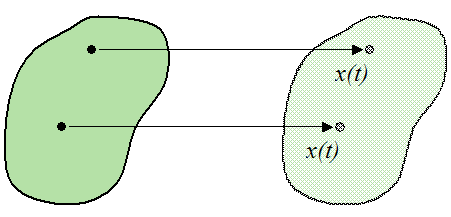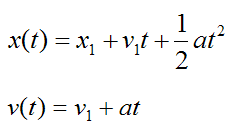Rectilinear Motion
Rectilinear motion is another name for straight-line motion. This type of motion describes the movement of a particle or a body.A body is said to experience rectilinear motion if any two particles of the body travel the same distance along two parallel straight lines. The figures below illustrate rectilinear motion for a particle and body.
Rectilinear motion for a particle:

Rectilinear motion for a body:

In the above figures, x(t) represents the position of the particles along the direction of motion, as a function of time t.
Given the position of the particles, x(t), we can calculate the displacement, velocity, and acceleration. These are important quantities to consider when evaluating the kinematics of a problem.
A common assumption, which applies to numerous problems involving rectilinear motion, is that acceleration is constant. With acceleration as constant we can derive equations for the position, displacement, and velocity of a particle, or body experiencing rectilinear motion.
The easiest way to derive these equations is by using Calculus.
The acceleration is given by

where a is the acceleration, which we define as constant.
Integrate the above equation with respect to time, to obtain velocity. This gives us
where v(t) is the velocity and C1 is a constant.
Integrate the above equation with respect to time, to obtain position. This gives us

where x(t) is the position and C2 is a constant.
The constants C1 and C2 are determined by the initial conditions at time t = 0. The initial conditions are:
At time t = 0 the position is x1.
At time t = 0 the velocity is v1.
Substituting these two initial conditions into the above two equations we get

Therefore C1 = v1 and C2 = x1.
This gives us

For convenience, set x(t) = x2 and v(t) = v2. As a result

Displacement is defined as Δd = x2−x1. Therefore, equation (1) becomes

If we wish to find an equation that doesn’t involve time t we can combine equations (2) and (3) to eliminate time as a variable. This gives us

Equations (1), (2), (3), and (4) fully describe the motion of particles, or bodies experiencing rectilinear (straight-line) motion, where acceleration a is constant.
For the cases where acceleration is not constant, new expressions have to be derived for the position, displacement, and velocity of a particle. If the acceleration is known as a function of time, we can use Calculus to find the position, displacement, and velocity, in the same manner as before.
Alternatively, if we are given the position x(t) as a function of time, we determine the velocity by differentiating x(t) once, and we determine the acceleration by differentiating x(t) twice.
For example, let's say the position x(t) of a particle is given by

Thus, the velocity v(t) is given by

The acceleration a(t) is given by

Return to Kinematics page
Return to Real World Physics Problems home page
Free Newsletter
Subscribe to my free newsletter below. In it I explore physics ideas that seem like science fiction but could become reality in the distant future. I develop these ideas with the help of AI. I will send it out a few times a month.